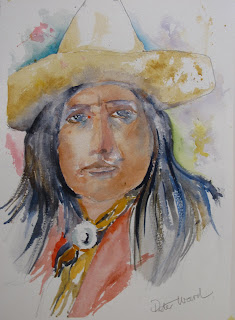This months competition between Mick Carney www.thepaintingstruggle.blogspot.com/ was my choice. Mick posted his painting yesterday.
Ostoho Apache Cowboy Early 1900's
This is one of many striking photographs I have from (mainly) the first people site. They are the work of Edward Curtis a famous, and controversial photographer who recorded thousands of images of early ethnic aboriginal Americans. There is a possibility I got this one from another source I'm not quite certain so I thought I'd better say that. I know nothing more about this individual but it seems obvious he is from a later period when the Apache wars were becoming a distant memory.
Ostoho- Saunders Waterford A3 Rough
What were the problems with this one? To begin with, as always with these Indian subjects, the original is in black and white and very starkly contrasted. The features stand out but there are large dark areas, with no detail on both the left and right of the face and under the brim of the hat. What to do? I'm sure the lack of detail and very strong contrast is a feature of early photography so why follow this faultline and overemphasize the darks? The hat itself is obviously quite light which you can see quite clearly so by the same token the underside of the brim, although in shadow, must be similar.
My approach is based on the teachings of Charles Reid who I try to emulate. I first did a loose but reasonably accurate (hopefully) drawing then painted the features beginning, as always, with the eyes, nose and mouth. I don't aim for a superealistic result because I don't want to achieve that even if I were capable of doing so. Colours were my usual Cadmium Red Light, Yellow Ochre (for darker features) and various blues, Cerulean, Cobalt and even Ultramarine. I used Burnt Sienna instead of the Red to darken the features and remove any trace of pink (hi Hap). If you study photos of Apaches they do look to have quite dark features as do many other Amerindians. Brushes were my usual Isabey retractable No.6 for the eyes, nose and mouth, with Rosemary or Da Vinci Kolinsky No.6 and either da Vinci Artissimo 44 Size 2 or Rosemary Series 33 No 9 Kolinsky for the remainder. The hat was Raw Sienna and/or Yellow Ochre with mainly a mix of Ultramarine Blue and Burnt Sienna, mixed on the paper for the hair, and I think some Raw Umber in there somewhere. The colours in his shirt and ornament comprise Gold Ochre (W & N PY42), Cadmium Red Pale (Rowney PR108) with touches of Permanent Carmine (W & N PR N/A). I think thats pretty much it.
How do I view this painting? Overall I am quite pleased with it although I was concerned that in my efforts to get the correct skin colours, and handling the very dark areas, I was in danger of `dirtying' the final result. I tried to correct this with some sponging off paint. My other concern is that I made the eyes slightly too large. This is always a problem with eyes. Are they too small or too large? Generally the tendency is to make them too large. What do you think? It's Micks turn for the May challenge. I wonder what he has in store this time?


















